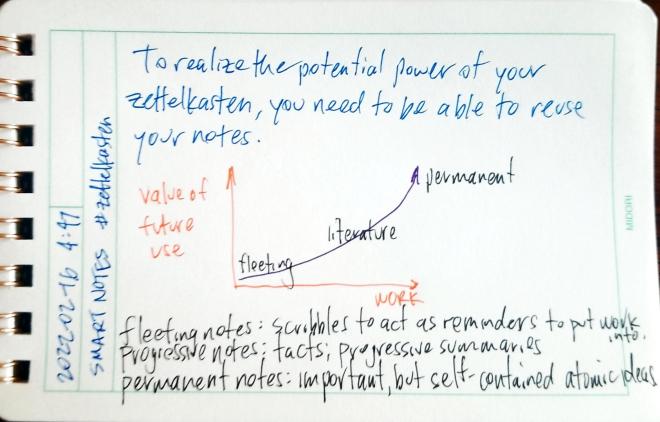Month: February 2022
A smidgen of its use stems from the mistranslation of some Luhmann work which is better read as “secondary memory”.
One of my favorites is Eminem’s “stacking ammo“.
Zettelkasten Overreach
The basic zettelkasten note taking method is very simple and clear cut as originally described by Konrad Gessner in Pandectarum sive Partitionum Universalium (Zurich: Christoph Froschauer. Fol. 19-20, 1548) to Sönke Ahrens’s book How to Take Smart Notes: One Simple Technique to Boost Writing, Learning and Thinking – for Students, Academics and Nonfiction Book Writers. Just a handful of bullet points can outline the elegance and simplicity of the system. This dramatic simplicity leads to some tremendous value and complexity.
However, in modern use as seen online since roughly 2018 on, the idea and the digital tools surrounding it, has seen some severe mission creep. Zettlekasten has moved to the fad stage and we’re “zettlecasting” everything under the sun. While it can be used as a productivity tool specifically for writing, some are adapting and using it (and tools built for it) for productivity use writ-large. This includes project management or GTD (Getting Things Done) functions. Some are using it as a wiki, digital garden, or personal knowledge management system for aggregating ideas and cross linking them over time. Others are using it as a journal or diary with scheduling and calendaring functions tacked on. Still others are using it to collect facts and force the system to do spaced repetition. These additional functionalities can be great and even incredibly useful, but they’re going far beyond the purpose-fit functionality of what a zettelkasten system was originally designed to do.
Ahrens highlights the zettelkasten method as being simply and specifically designed to do its particular workflow well—no more, no less. He cleverly analogizes slip boxes to their larger box cousins, the shipping container, and the way that that they revolutionized the shipping industry.
In hindsight, we know why they failed: The ship owners tried to integrate the container into their usual way of working without changing the infrastructure and their routines. They tried to benefit from the obvious simplicity of loading containers onto ships without letting go of what they were used to.
Following this analogy, many people are currently trying to not only revolutionize shipping, but sourcing, manufacturing, distribution, and marketing as well. While this may be interesting and the digital tools might accommodate some of these functions, are they really custom built from start to finish to really excel at these functionalities? Can they really do all of them at once? While some may come close and do well enough, the added complexity and overreach of all these functionalities may be diluting the base power of what the zettelkasten is capable.
People conflate the idea of note taking and the zettelkasten with tools like Obsidian, Logseq, and Roam Research. This is not necessarily a good thing. If they expect it to do everything and it’s not capable of that or well designed to do what they expect, they’re more likely to get confused, frustrated, and eventually give up. I’ve seen it happening more and more.
As an example, in a book club related to Ahrens’ text in which many highly educated and talented people have been using these tools and have even previously read the book, many are still far too confused about what these tools are and the value that can come from them.
For those who are just coming to the idea of a zettelkasten, I recommend you limit yourselves to just that basic functionality. Don’t muddy the waters with other productivity functions, to do lists, journals, diaries, kitchen sinks, or the latest wiz-bang plugin. Don’t throw in buzz words like GTD and MOC. Stick to the simplest script for a few months and focus on finely honing a small handful of questions and ideas each day from your reading to see what happens. Write, link, repeat. Don’t get caught up in the collector’s fallacy by keeping and saving every single fleeting note (thought) you’ve got (or if you must, put them into a folder off to the side). Focus on the core idea.
Once you’ve got that part down and it’s working for you, then consider adding on those other functionalities. Experiment with them; see what works. But don’t be surprised if those other portions aren’t the magic bullet that is going to revolutionize your life. We’re likely to need new tools, functionality, and a system built from start to finish, to make those other things a useful reality.
Featured image: zettelkasten flickr photo by x28x28de shared under a Creative Commons (BY-SA) license
Time lapse of The Dawn of Everything Book Club (End)
You should also have at least one historian: maybe Ann M. Blair, Richard Yeo, Matthew Daniel Eddy (@BookScribbler), or Markus Krajewski?
Jeremy Dean (@Dr_JDean) and Remi Kalir (@RemiKalir) are intriguing within both the education and technology space.
For a dramatically different perspective from most of both my suggestions and others I’ve seen on the thread, a Sketchnotes representative like Mike Rohde (@RohDesign) would be nice.

📅Saturday, February 19, 2022
⏰ 9:00am – 1:00pm Pacific
Focusing on personal libraries on one’s own site and how they can interact with each other.
#DistributedLibraries RSVP to the main page or this tweet.
https://events.indieweb.org/2022/02/personal-libraries-pop-up-session-Wax8N17zQuY0
I’ve gone back further than this for the commonplace and the florilegium which helped to influence their creation, though I’ve not delved into the specific invention or general use of indices in the space heavily. I suspected that they grew out of the tradition of using headwords, though I’m not sure that indices became more popular until the paper by John Locke in 1689 (in French) or 1706 (in English).
I’ll put Dr. Duncan’s book into the hopper and see what he’s got to say on the topic.



We caught ’em!
— Perusall (@Perusall) February 21, 2022
https://hyp.is/A9EcXpR0Eey_JGdvKnxDPg/twitter.com/perusall/status/1495945680002719751
Followed Anotación Web
Recursos en español para anotar la web




